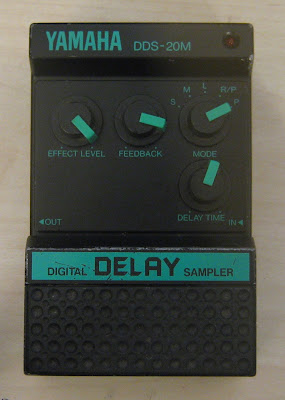The mechanical design is a little different - all of the controls are recessed at a height below the footswitch and there is a "unibrow" along the top with the logos and LED.
There are no schematics and not a huge amount of info on these that I could find online, other than there was a range of pedals in this form factor. No signs of life.
After looking on the inside, I got the impression that someone else had attempted a fix. There was a resistor between the +9V and ground pads of the DC jack (?), the ground trace had been cut in two places for some reason and a wire had been soldered in to replace it. I can't see why the resistor between 9V and ground would be needed for anything other than wasting power, so I removed it. I also found that the ground from the DC jack was not connected to circuit ground. Adding a jumper was enough to get this to fire up with a DC supply, but not with a battery. It's possible that the resistor was originally connected between jack ground and circuit ground but as it was several kilo-ohms a wire would be a better solution.
The pedal uses a 2 board design, connected together with wires. Both are single-sided PCBs that look like a phenolic paper material and no through-hole plating anywhere. This is pretty typical for 80s Japanese electronics but it can mean that any board-mounted hardware can be fragile as there is only solder on one side of the board anchoring it place. In this delay, the output jack had taken some force (probably a cable was stepped on) and the pad to the jack tip had broken, this had to be re-soldered to get an output signal. One of the PCBs has most of the analog parts, the inner one has the digital controller and the pots and rotary switch.
 |
| 2 wires added and a diode replaced |
 |
| Analog board, component side |
The analog board has a 4066 for bypass/effected switching, 5534 opamps, a Motorola M5218 audio pre-amp (I have only seen this part in Japanese pedals, I think the original Boss DS-1 used something like this), μpc1571 compander (NEC's NE571 clone) and the chip in the bottom left corner is an LM311 comparator. The comparator is forming part of a sigma-delta ADC with the digital controller, much like the Boss DD-2 and the Digitech PDS series of delays.
 |
| Bizarre vertical component assemblies |
I thought the parts marked "< RIVER < RIVER" were SIP ICs, but they are actually components standing vertically! They seem to be clamped together at the top. I don't know if there was automated machines to produce these assemblies or if they were re-used in other designs but it's surprising that this was cheap enough to be worth the effort.
 | |
| Digital board |
The digital controller is an "M654131". No info on this, probably a Yamaha custom. Maybe they used it somewhere else in a different product. I don't have any pictures of the back side of this board so I don't know what type of memory is used. It looks like there are two 9-pin SIPs connected straight to the controller so I would guess 2 64k DRAMs, assuming this is an 8-bit delay.
It sounds great. I like that these early digital designs use companders and have simple master clock signals. It's like a holdover from the days of analog delay designs. This one can pitch-shift the delay signal smoothly, unlike some more modern delays.

